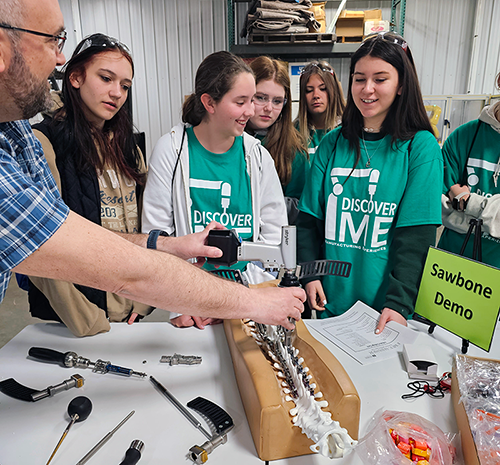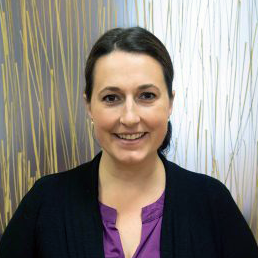Opportunity to Revamp Workforce Through Industry-Education Collaboration

By Nichole Rouached, Talent Director at OrthoWorx
Manufacturing and philanthropy: you might not think they go together. But both drive innovation and are, I’d contend, unique to the U.S. and the American idea.
I discovered a paper in graduate school that argued that nonprofits formed because of our belief in the separation of church and state. Traditionally, churches were the source of social services, health care, and education, meeting a broad set of critical needs for communities.
Nonprofits formed our own third economy. Philanthropy grew to be a driving economic force, representing 10 percent of our GDP. This enables nonprofits to thrive and ultimately be a leading employer in the U.S.—larger even than manufacturing!
Of course, in our region of northern Indiana, manufacturing is a leading employer. We have one of the largest concentrations of manufacturing in the country. This concentration has allowed northern Indiana to create unique partnerships between industry and nonprofits. We’re beginning to see how these partnerships drive transformation in education.
Philanthropy touches many industries, from health care to the arts, but education is one area where we’re just beginning to see a new wave of innovation. Colleges and universities have a strong history of philanthropic engagement, and their endowments are some of the largest in existence.
We need to apply this process and create a similar system in public education for our K-12 schools. Public education does a lot with philanthropy, with schools and teachers working with various foundations. Teachers are very creative; for example, they create Amazon Wish Lists to meet many basic classroom and student needs. I know this well, giving a Wawasee Lake’s worth of Goldfish to my son’s own classroom! We need to systemically change how we fund education, while simultaneously creating innovative educational solutions that meet the talent needs of local industry.
Public education in the K-12 space faces many challenges: underfunding for wages, aging facilities, and an ever-growing number of educational pathways, just to name a few. There has been a growing divide between urban, suburban, and rural schools for generations in public education. The traditional education funding model through property taxes creates several issues, including greater inequity and the public’s lack of recognition that funding must go beyond tax system revenue. Rural education partners face their own set of issues—particularly around shrinking enrollment and transportation—which presents a greater need to shift how we fund programs. As enrollment shrinks for schools, this translates into a decreasing talent pool for industry partners.
Partners across the state, such as the Indiana Chamber and Conexus, are researching, discussing, and facilitating conversations and solutions around the “Leaking Talent Pipeline.” At OrthoWorx, we hear this from our industry partners all the time; not just hard skills, but key employability skills like time management, communication, critical thinking, initiative, and self-confidence are missing from their applicants—and even their current employees.
Just to be clear on this: educators are not at fault for this growing skills gap. They are saving our students from an antiquated approach to education. What is missing? For one, a connection between teachers and industry. Employers can make the most meaningful impact in their area of education through innovative philanthropic models combined with industry-influenced pedagogical practices.
Whitko Career Academy is a great example of this innovation. We’re seeing this trend growing with other partners like Warsaw Community Schools and Manchester Community Schools, who are engaging industry in new ways and rethinking how our curriculum aligns with local employers.
Northeast Indiana’s enrollment is shrinking. According to a New American Economy report, we had zero-percent population growth in 2016. More recent models show the region moving to a net loss in birth rates. Yet industry is thriving: Kosciusko County—the Orthopedic Capital of the World®—remains a global leader in medical device manufacturing. Northeast Indiana accounts for 75.5% of Indiana’s 2021 gross regional product for orthopedic device manufacturing.
From 2010 to 2015, we saw 16 percent job growth in the medical device and technology industry, according to Northeast Indiana Regional Partnership’s 2020 Target Industry Report. Whitko Career Academy addresses workforce needs for several industries while leveraging resources and corporate partners for high-demand, high-wage positions beyond the K-12 system. It is up-skilling adult learners and creating new opportunity pathways through partnerships with the justice system—all while engaging industry.
Corporate partnerships are critical, not just to address the vast underfunding of education, but also to meet the needs of students, teachers, administrators, and even school facilities by providing transformative and industry-responsive curricula. Our partners at Purdue University’s Indiana Manufacturing Competitiveness Center (IN-MaC) help facilitate an academy model by convening education, industry, community partners, and higher education.
We’re asking philanthropic partners in our area to join discussions to establish this new model of funding and pedagogy for the public education system. We’re fortunate to be in a county that works with both Dekko Foundation and Don Wood Foundation. Industry partnerships—both in curriculum and skill expertise through coursework—create meaningful experiences and vital context for student learning. Educators create industry-responsive curricula reflective of current career opportunities, but they need industry and philanthropy at the table.
There is a crisis in public education, but the innovative approach of northern Indiana schools and industry partners serves as a model for a skilled workforce and thriving communities. Philanthropy partners’ resources can spark this innovation and carry on a national legacy of philanthropy and manufacturing.

